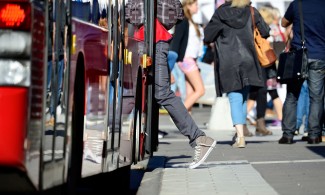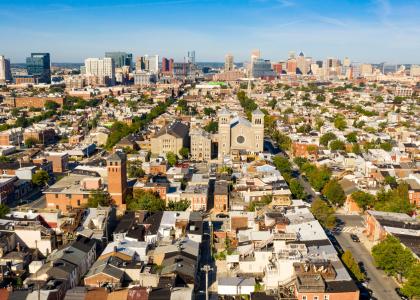A $3 billion program in the recent Inflation Reduction Act provides communities a key opportunity to invest in improving equitable access to efficient, low-carbon transportation. Known as the Neighborhood Access and Equity Grant Program, the funding is a critical complement to the bill’s investments in electric vehicles.
The program could be used to improve neighborhood walkability and ease access to transit, shared bicycles, and other micromobility options for millions of people around the country. While the Federal Highway Administration (FHWA) will likely issue guidance to clarify possible uses of the funds, it’s not too early for local governments to consider how they might apply to use them.
A Needed Complement to Electric Vehicle Funding
The transportation sector is the largest contributor of greenhouse gas (GHG) emissions in the United States, accounting for 27% of total emissions. Tackling these emissions will require both support for electric vehicles (EVs) and an increase in the efficiency of municipal transportation networks. Shared transportation for passengers and improvements to the efficiency of goods movement through enhanced logistics and the use of multimodal freight will help create transportation systems that not only are low carbon but also serve everyone.
The Infrastructure Investment and Jobs Act enacted last year increased funding for public transit and multimodal freight projects. More recently, the major climate and health law enacted in August, the Inflation Reduction Act, included significant funding supporting EVs. It included a light-duty EV tax credit worth up to $7,500 (with limits for the purchaser’s income and the price of the vehicle), a used-EV tax credit worth up to $4,000, 30% tax credits up to $40,000 for commercial EVs, $3 billion in funding for electrification of the Postal Service’s fleet, and $1 billion for replacing outdated nonelectric heavy-duty vehicles with new EVs.
The Inflation Reduction Act’s transportation funding went beyond EVs, though. It set aside $3 billion for transportation equity and environmental justice initiatives, including supporting access to transportation for low-income and historically marginalized communities. This is a considerably smaller pot of money than was set aside for electrification efforts, but it marks a first step toward explicitly supporting equitable low-carbon transportation in low-income communities.
FHWA will distribute the dollars available in the Neighborhood Access and Equity Grant Program through a competitive process that has yet to be determined. The program will focus on “improving walkability, safety, and affordable transportation access” through equitable transportation planning and infrastructure improvements.
Many neighborhoods—particularly low-income ones—are not shaped to fit the needs of the people living within them, often facilitating car travel over other modes, such as walking, biking, and transit. $1.89 billion within the Neighborhood Access and Equity Grants Program will be directed toward addressing these issues around the country, and an additional $1.1 billion is reserved specifically for such programs targeting low-income communities. Local governments, public authorities, metropolitan planning organizations, and several other groups will all be eligible to apply for funding through this program.
This funding—the first of its kind—will help address mobility needs in low-income and environmental justice communities as progress is made to reduce GHG emissions from transportation.
The program could also significantly reduce transportation costs for low-income households. Improving connectivity to job centers, goods, and services by improving walkability and transit access may decrease the need for a car, removing a significant cost burden. Car ownership can be especially onerous for low-income households. On top of the cost of purchasing a vehicle, insurance, maintenance, and fuel costs can pose a large financial obstacle for some.
Local Governments Could Use Funds to Implement Proven Transportation Policies
While local governments await federal guidance that will specify the types of projects that qualify for Neighborhood Access and Equity Grant Program funding, they can plan ahead now by considering several proven transportation policies they could potentially implement with the help of these grants.
Complete Streets
Complete Streets policies have become best practice for cities interested in creating a template for more interconnected, safe, and easily traversable spaces. The creation and implementation of city-wide Complete Streets requirements for land use planning ensures that roads are accessible to all population groups and transportation types, including transit vehicles, bicycles, and pedestrians. Over 30% of trips within metropolitan areas cover only a mile or less, so ensuring that pedestrians and bicyclists have safe and unobstructed paths to goods, services, and transit facilities is essential.
Boston’s Complete Streets Design Guidelines provide a good example of how city requirements can support all modes of transportation across an entire city, preserving space for pedestrians and commuters utilizing efficient modes of transportation.
Connecting Low-Income Housing to Transit
Locating low-income housing near transit facilities is critical. Many low-income residents may find the costs of owning a personal vehicle to be prohibitive, so ensuring that such residents have access to housing that’s within walking distance of affordable transportation options such as public transit is imperative.
To pursue this goal, cities can create transit-oriented development districts with carved out requirements for low-income housing, improve siting practices for low-income housing, and preserve existing affordable housing around transit. San Francisco sets a positive example with its General Plan Housing Element, which establishes several density levels for residential zoning meant to increase housing stock around transit.
Funding and Subsidizing Efficient Transportation
For moving large numbers of people, transit is both the most affordable and the least GHG-intensive mode. This makes sustaining local transit infrastructure and increasing the reach of transit routes crucial to serving both a city’s climate goals and city residents’ day-to-day lives. Common funding strategies for transit at the local level include sales taxes, property taxes, road user fees, revenues from toll roads, and parking fees, but these federal grants will allow communities to fund improvement projects that otherwise are usually out of reach. Given the immense cost-saving and GHG reduction potential of a well-maintained transit system, ensuring that as many people as possible can access such services is vital.
Subsidizing transit passes for low-income residents will help connect more city residents with the housing, job centers, and goods and services they require. Subsidizing bikeshare subscriptions and other modes of efficient micromobility can also help. Boston, New York, and Washington, DC, are among the growing list of cities across the country that offer discounted bikeshare passes for low-income residents.
Cities Should Plan for Funding Opportunities
There will be a variety of ways that cities and municipalities around the country can make effective use of this new funding. By exploring strategic possibilities now, they can set themselves up well to pursue grants when guidance is available.



